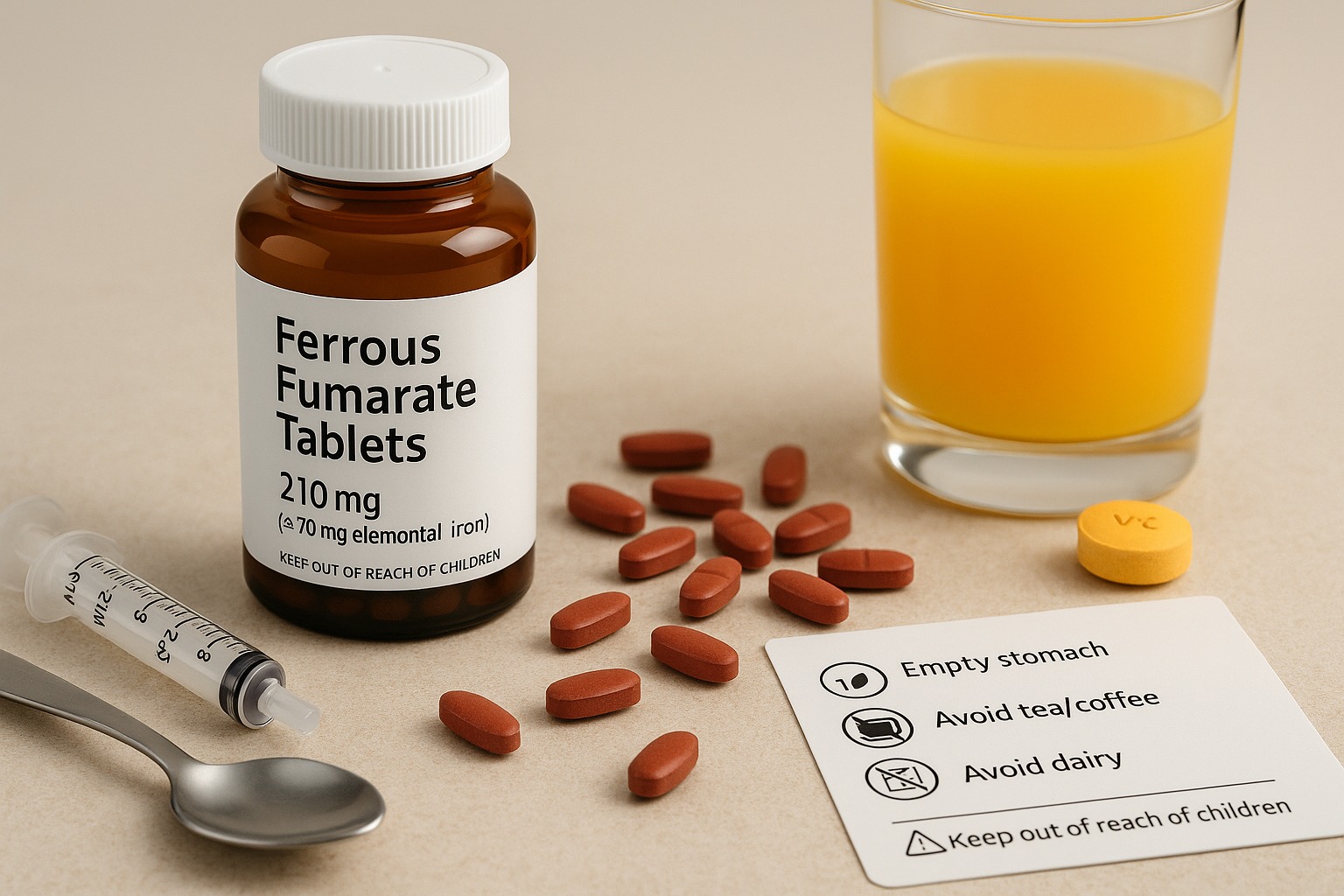Ferrous fumarate is an iron supplement used to treat or prevent iron-deficiency anaemia. It’s available worldwide under many brand names (for example Galfer, Fersamal, and generics) in tablets, capsules and liquids.
Education only — not medical advice. Labels, strengths and OTC/prescription status differ by country. Always follow your clinician and the Patient Information Leaflet for your exact product.
What ferrous fumarate is used for
- Treatment of iron-deficiency anaemia confirmed by blood tests (low haemoglobin and ferritin).
- Prevention in higher-risk groups when advised (pregnancy, heavy periods, frequent blood donation, certain diets, post-surgery/blood loss).
Correcting iron deficiency can improve tiredness, breathlessness, headaches, hair loss and brittle nails.
Strengths & “elemental iron” explained
Iron products list the salt amount (ferrous fumarate) and the elemental iron your body actually uses.
Typical strengths you’ll see on labels:
- 210 mg ferrous fumarate → ≈70 mg elemental iron
- 300–305 mg ferrous fumarate → ≈99–101 mg elemental iron
- 322–324 mg ferrous fumarate → ≈105–106 mg elemental iron
When comparing brands or switching from ferrous sulfate, always compare the elemental iron, not just the tablet size.
Dosage: how clinicians usually prescribe it
Your exact plan depends on your blood tests and how well you tolerate iron.
- Common treatment dose: 60–120 mg elemental iron per day (for example, one 210 mg tablet once or twice daily, or one 300/324 mg tablet once daily).
- Alternate-day dosing: Many people absorb iron better and have fewer side effects taking the dose every other day — ask your clinician if this approach suits you.
- Prevention / maintenance: Lower elemental doses may be used based on ferritin and clinical need.
Duration: Treatment often continues for at least 3 months after haemoglobin normalises to refill body stores (ferritin). Don’t stop early unless your clinician says so.
How to take ferrous fumarate (step-by-step)
- Best on an empty stomach (1 hour before or 2 hours after food). If it upsets your stomach, take with a small snack or at bedtime.
- Vitamin C helps absorption (a small glass of orange juice or a vitamin-C tablet if appropriate).
- Avoid near your dose (separate by 2–4 hours):
- Tea or coffee
- Milk/dairy or calcium supplements
- High-fibre bran cereals
- Antacids, PPIs, H2 blockers
- Levothyroxine (leave 4 hours), tetracycline/quinolone antibiotics, bisphosphonates
- Swallow whole unless your leaflet says the tablet can be broken/chewed.
- Liquid: measure with the supplied syringe/spoon; rinse your mouth or drink water afterwards to reduce tooth staining.
- Missed dose: take it the same day when remembered; skip if it’s close to the next dose—don’t double.
Side effects & simple fixes
Common (usually improve as your body adapts):
- Nausea, upset stomach, metallic taste
- Constipation or diarrhoea
- Dark stools (harmless)
- Tooth staining with liquids
What helps
- Try every-other-day dosing or switch the timing.
- Extra fluids, fibre and gentle exercise; consider a stool softener if recommended.
- If symptoms persist, ask about a lower elemental dose, a different iron salt, or (when appropriate) IV iron.
Get medical help urgently for:
- Signs of allergic reaction (swelling, rash, breathing difficulty)
- Black, tarry stools with dizziness/weakness (possible bleeding)
Safety essentials
- Keep out of reach of children. Accidental iron overdose can be fatal to children—store locked, in child-resistant packaging.
- Don’t self-treat long-term without blood tests; too much iron can be harmful.
- Tell your clinician if you have kidney disease, stomach/intestinal ulcers, inflammatory bowel disease, transfusions, or iron-overload disorders (e.g., haemochromatosis).
- Pregnancy & breastfeeding: Iron is widely used in pregnancy; dose targets differ by region—follow your midwife/obstetrician’s plan.
Interactions to discuss with your pharmacist/clinician
- Levothyroxine (separate by ≥4 h)
- Tetracycline/quinolone antibiotics (separate by 2–6 h)
- PPIs/H2 blockers/antacids, calcium, zinc, magnesium (reduce absorption)
- Bisphosphonates (at least 2 h apart)
- Foods/drinks that hinder absorption: tea, coffee, dairy, bran
- Vitamin C may enhance absorption (if suitable for you)
Results: what to expect
- Many people feel a bit more energetic within 1–2 weeks.
- Haemoglobin typically rises by ~1 g/dL (10 g/L) every 2–3 weeks once absorption is adequate.
- Ferritin can take 1–3 months longer to refill—keep taking iron as directed even if you feel better.
Ferrous fumarate vs ferrous sulfate — which is better?
Both work when taken correctly. Ferrous fumarate tablets contain more elemental iron per tablet than many ferrous sulfate tablets (useful if you prefer fewer pills), but tolerance varies from person to person. If one salt causes stomach trouble, a different salt, lower elemental dose, alternate-day dosing, or liquid may suit you better.
FAQs
Is 210 mg the same as 65 mg iron?
Roughly. 210 mg ferrous fumarate ≈ 70 mg elemental iron (check your leaflet).
Can I take it with food?
Empty stomach gives best absorption, but light food is fine if you feel nauseated—just avoid tea/coffee/dairy around the dose.
Why are my stools black?
Dark stools are expected with iron. Seek urgent care if stools are tarry and you feel dizzy/weak.
What if I keep getting constipated?
Hydrate, increase fibre, consider a stool softener, or ask about alternate-day dosing or a lower elemental dose.
How long should I stay on it?
Often until haemoglobin normalises plus at least 3 months to rebuild iron stores—your follow-up blood tests will guide the stop date.
Bottom line
Ferrous fumarate is a reliable, widely available option for treating iron-deficiency anaemia. Focus on the elemental iron, take it correctly and consistently, keep it locked away from children, and follow up with blood tests to confirm recovery. If side effects are tough, don’t quit—speak with your clinician; small adjustments often make iron therapy comfortable and effective.


Leave a Comment